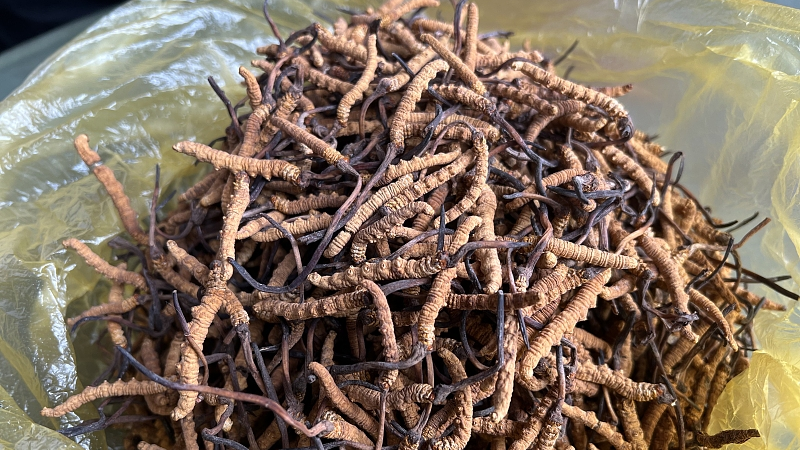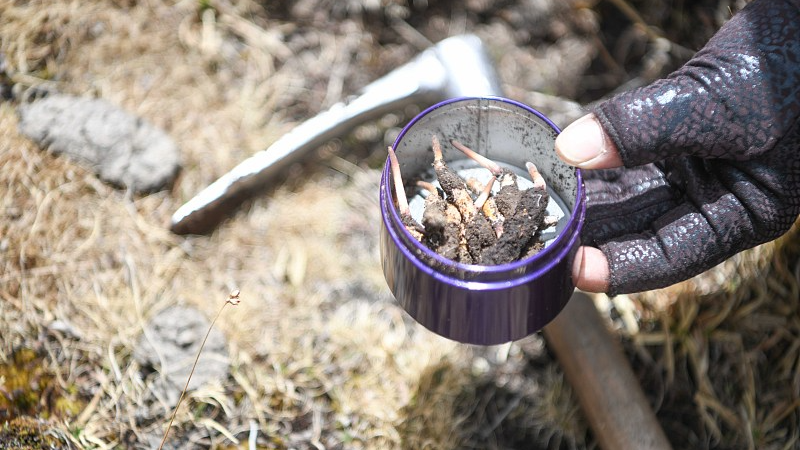
The Chinese caterpillar fungus. /CFP
The Chinese caterpillar fungus. /CFP
Editor's note: Li Yi is working at Yangzhou University as a mycologist. He has a Phd degree in mycology from the Institute of Microbiology, the Chinese Academy of Sciences, and has been researching on the Chinese caterpillar fungus since 2006. The article reflects the author's opinions and not necessarily those of CGTN.
The objectives of the Convention on Biological Diversity are to promote sustainable utilization of components of biological diversity. It's important to balance the sustainable use of natural resources in biodiversity conservation.
The Chinese caterpillar fungus (scientific name Ophiocordyceps sinensis), also called Yartsa Gunbu or Yartsa for short in local communities, is among the world's most precious fungal species. It has been widely used as a tonic and dietary supplement in China, as well as in East and Southeast Asia. The collecting of the fungus was acrucial income resource for some of the most economically disadvantaged communities living at high altitudes on the Qinghai-Tibet Plateau (including the Himalayas).
But due to climate change and over-harvesting in recent decades on the plateau, both the distribution area and per unit yield has shrunk. The expected potential habitat loss of Yartsa could reach 36.6 percent or more for the next 30 years. The species has been assessed as vulnerable in the recent IUCN Red List assessment of macro-fungi in China and worldwide. Hence, the fungus requires effective conservation.
Meanwhile, Yartsa collecting was the most important income source for local communities, impacting more than one million people, a vast majority of them were Tibetans. The plateau has the harshest conditions for human life and is the most underdeveloped areas in the country. Yartsa also impacts every single human life that are living in the production area. Accordingly, we confront challenges to balance the conservation of this precious natural resources and ensuring the local livelihood.

A villager displays a freshly harvested caterpillar fungus in Lhasa, capital of the Tibet Autonomous Region, SW China, April 21, 2022. /CFP
A villager displays a freshly harvested caterpillar fungus in Lhasa, capital of the Tibet Autonomous Region, SW China, April 21, 2022. /CFP
Some Himalayan countries including Bhutan and Nepal adopted strict bans on the collection, trade, distribution, carriage, and export of the fungus in the last century, but they were unsuccessful due to the remoteness of the habitat and an inadequate government presence. The ban on harvesting would have a detrimental impact on people's livelihood. Some less strict regulation strategies were implemented in China where almost 95 percent of Yartsa were produced. The fungus has long been listed as a protected species under the Second-Class Category in China by the State Forestry and Grassland Administration since 1999, which means collecting or selling the fungus should receive special permission from the provincial government. The local governments would play critical roles here.
To achieve effective conservation, local governments from the main production areas in China, such as China's Tibet Autonomous Region, Qinghai and Sichuan provinces, have introduced different policies and management strategies. Apart from several identified vulnerable ecosystems like Qilian Mountains, Yartsa harvesting was permitted but highly organized and under strict supervision.
Only designated local communities were permitted and awarded a collection certificate in China's Tibet Autonomous Region. Around 450,000 certificates were issued annually in China's Tibet Autonomous Region, in some core production regions that were sparsely populated in Qinghai Province. The outsiders may be allowed entry, but must pay for the certificate and the total number of certificates were controlled by the local government. A more effective controlling method was the particular restriction of the collecting period. Although the collecting period may vary for different regions, it was usually only permitted for a time line of 40-50 days.
A dead time line would not only release the pressure of over-exploitation and allow more individuals to be matured, which would stabilize the fungal population underground. Other measures that have proven effective include establishing stationary camp sites, which were organized by the presiding governments of the township or countryside. The management systems can ensure that most profits were shared by the local communities. Additionally, Yartsa collection has become an important local culture on the plateau, while more locals are aware about its significance.
Although major achievements have accomplished, more statistical supports from field observation are reflecting that more population dynamics are needed. Production areas, especially those lying on the edge of the Qinghai-Tibet Plateau and having lower elevations, face higher risk of extinction, and more natural reserves are needed to conserve the population and genetic diversity of this species. More practical effective managing methods of this species could be taken such as establishing a National Nature Reserves, since 17 percent of the modeled current distribution is covered by those reserves in the country.
The model of conserving the Chinese caterpillar fungus on the Qinghai-Tibet Plateau should be used as a reference point for other countries, which harbor this species. It can also provide valuable insights for the conservation and management of natural resources, especially those with high economic values.
(If you want to contribute and have specific expertise, please contact us at opinions@cgtn.com. Follow @thouse_opinions on Twitter to discover the latest commentaries in the CGTN Opinion Section.)